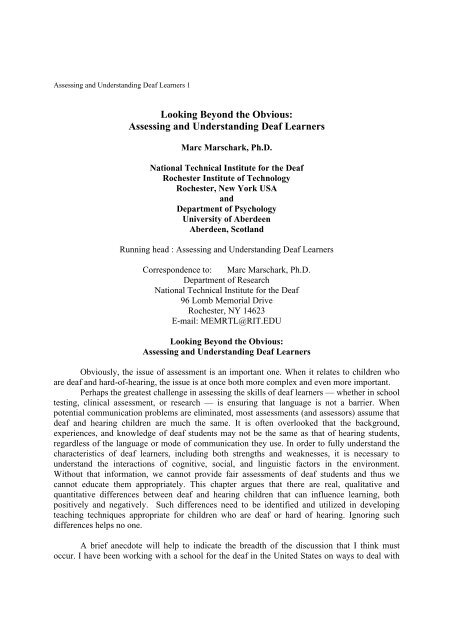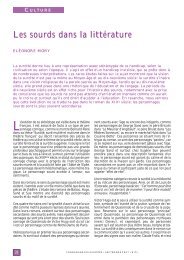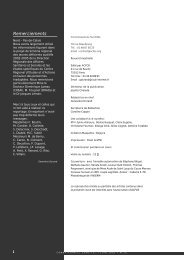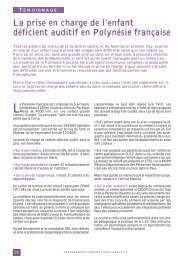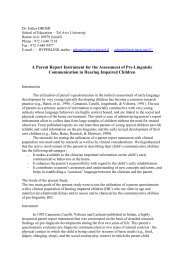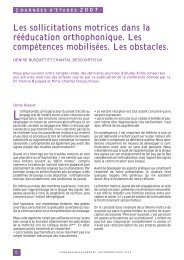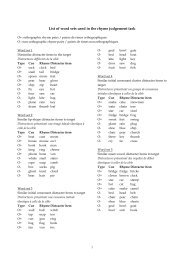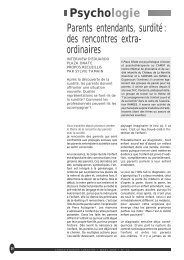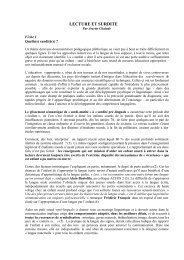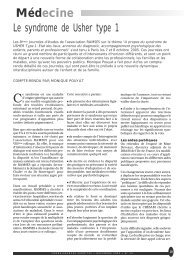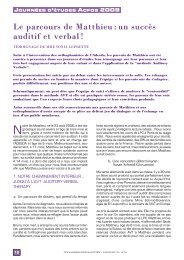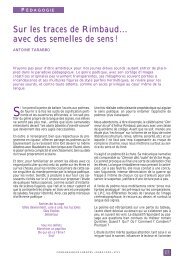Assessing and Understanding Deaf Learners - ACFOS
Assessing and Understanding Deaf Learners - ACFOS
Assessing and Understanding Deaf Learners - ACFOS
You also want an ePaper? Increase the reach of your titles
YUMPU automatically turns print PDFs into web optimized ePapers that Google loves.
<strong>Assessing</strong> <strong>and</strong> Underst<strong>and</strong>ing <strong>Deaf</strong> <strong>Learners</strong> 4within different (deaf) adults, <strong>and</strong> they are more likely than deaf children with hearing parents tohave experienced consistent parenting behaviors <strong>and</strong> effective communication from an early age.Interactions with deaf individuals outside of the immediate family thus are more likely to besimilar to those within the family. Partly as a result of this consistency, deaf children of deaffamilies tend to have relatively greater self-esteem <strong>and</strong> a greater sense of being in control of theirown lives, factors that will contribute to later academic achievement. <strong>Deaf</strong> children of hearingparents can be just as confident <strong>and</strong> secure as those of deaf parents, of course, but it may requiremore conscious planning by hearing parents to ensure that their children have the right kind ofpersonality-building experiences (see Marschark, Lang, & Albertini, in press, Chapter 4).Communication <strong>and</strong> LanguageOne way in which deaf <strong>and</strong> hearing children clearly differ is in the availability of“effective communication” alluded to above. <strong>Deaf</strong> children who have hearing parents frequentlydo not have full (if any) access to language during the first 1
<strong>Assessing</strong> <strong>and</strong> Underst<strong>and</strong>ing <strong>Deaf</strong> <strong>Learners</strong> 5the same time foster language <strong>and</strong> cognitive development, through a variety of similar strategies.When they point to an interesting thing, they name it, <strong>and</strong> frequently point at it again, thushelping to connect the name the with the thing. They do not begin a signed utterance until thechild is actually paying attention (something difficult for hearing parents to adjust to), so that thechild does not have to switch attention back <strong>and</strong> forth. <strong>Deaf</strong> parents slow the rate ofcommunication relative to hearing parents, allowing their children more time to underst<strong>and</strong>messages, <strong>and</strong> they use shorter utterances. As with pointing, deaf parents also put important ornew information at both the beginning in the end of an utterance, ensuring that a childunderst<strong>and</strong>s the topic of discussion (Mohay, Milton, Hindmarsh, & Ganley, 1998). Importantly,these are not just factors of importance to parents, but essential aspects of communication foranyone involved in caring for, teaching, or evaluating deaf children.Taken together, these visually-based strategies do more than just gain attention <strong>and</strong>support communication: they form the basis for learning <strong>and</strong> development in other domains. Anumber of early intervention programs thus are starting to incorporate training for (hearing)parents in such techniques, Generally, children who are enrolled in early intervention programshave effective communication <strong>and</strong> affective bonds with their mothers, <strong>and</strong> who use signlanguage tend to show the greatest gains in development <strong>and</strong> early academic success (Calderon& Greenberg, 1997). While deaf parents’ intuitive parenting strategies may be particularlysupportive in these domains, with appropriate intervention, hearing parents can do this just aswell as deaf parents.AttentionAnother obvious difference between deaf <strong>and</strong> hearing children has recently gainedrecognition as worth investigating, albeit in a way distinct from what might be expected: theavailability of auditory information. The development of visual attention skills is clearlyimportant for deaf children. Discussions of visual attention in hearing children usually includethe role played by auditory information, <strong>and</strong> there now some evidence that there must be someconsideration of its contribution for hard of hearing <strong>and</strong> some “deaf” individuals as well.A variety of studies have shown that the developmental pattern of visual attention amongyoung deaf <strong>and</strong> hearing children is very similar. We know, for example, that parents (deaf orhearing) who use more visual communication with their (deaf or hearing) children are morelikely to have children who are better at maintaining joint visual attention with them (Spencer,2000). At the same time, auditory information — both elaborating about an object of attention<strong>and</strong> reinforcing the child for attending to it — appears to encourage hearing children to attend tothose objects longer. Unlike hearing children, who can attend to an object visually whileattending to parental language auditorally, deaf children have to switch their attention betweenan object of interest <strong>and</strong> the person who is communicating about the object. That switchingclearly has an impact on both the amount of information that might be communicated <strong>and</strong> thetime available to engage in visual exploration. It also affects a child’s interest in objects <strong>and</strong>communication as well as their willingness to attend to those who interrupt them (Harris,Clibbens, Chasin, & Tibbitts,1989).At least at preschool age, both deaf <strong>and</strong> hearing children appear to be equally good atmaintaining visual attention (Waxman & Spencer, 1997; but see Spencer, 2000, for variation as afunction of communication strategies of deaf <strong>and</strong> hearing mothers). By age 6, however, deafchildren tend to be more prone to visual distraction than hearing children (e.g., Quittner, Smith,
<strong>Assessing</strong> <strong>and</strong> Underst<strong>and</strong>ing <strong>Deaf</strong> <strong>Learners</strong> 6Osberger, Mitchell, & Katz, 1994). Quittner et al. (1994) showed quite clearly that residualhearing <strong>and</strong> use of hearing aids can support visual attention in children 6-8 years old. For olderchildren, 9-13 years old, cochlear implants were found to be even better.Note that the issue here is not about a link between cochlear implants <strong>and</strong> language, atleast not directly. The point is that auditory information supports visual attention <strong>and</strong> thus socialinteraction <strong>and</strong> learning in general. Specifically, young children’s experience in “triangulating”between an object, adults who identify or label things in the environment, <strong>and</strong> themselvesappears to play an important part in the development of visual attention <strong>and</strong>, probably, in earlyvocabulary (Spencer, 2000). The ability to make use of auditory cues is not an essential factor ineither of these, but it clearly is a supporting factor.Visual-SpatialProcessingGiven that deaf children’s learning depends primarily on visual information, it isimportant to recognize differences between them <strong>and</strong> their hearing age-mates — in bothdirections — in the domain of visual-spatial processing. <strong>Deaf</strong> individuals, for example, tend tobe faster than hearing individuals in redirecting visual attention from one spatial location toanother (Parasnis & Samar, 1985) <strong>and</strong> in their ability to detect motion in the periphery,especially when that if motion is language-relevant (Swisher, 1993). They also have anadvantage in their perception <strong>and</strong> memory for complex visual signs, in face discrimination(Bettger, Emmorey, McCullough, & Bellugi, 1997), <strong>and</strong> in the ability to generate <strong>and</strong> eithertransform or rotate mental images (Emmorey, 1998).The extensive literature on the generation <strong>and</strong> manipulation of mental images may beunfamiliar to many educators, so let me explain briefly. Imagine that you are st<strong>and</strong>ing in front ofthe Eiffel Tower looking toward it. When you have a good visual image of it, make the towerrise off the ground <strong>and</strong> rotate its base away from you, so that the television antenna on the topcomes down to point directly at you. Not everyone can do this kind of generation <strong>and</strong> rotation,but most people can with some degree of clarity. Assuming that you were able to do so, what doyou see? It should look like something approximating a large letter “X,” <strong>and</strong> there is no otherway to discern the result other than “visually.” The chances are that if you are deaf, this task waseasier (or faster) for you than if you are hearing. This does not mean that deaf people areuniformly better than hearing people in visual imagery. But exposure to sign language appears toresult in a neuropsychological organization that has advantages in some domains (Bettger et al.,1997; Emmorey, 1998), <strong>and</strong> this is one of them.The same holds for face recognition. Bettger et al. (1997) showed that adults <strong>and</strong>children who were native users of sign language showed enhanced ability to discriminate <strong>and</strong>recognize novel faces relative to hearing peers. The two groups were essentially equivalent,however, in their ability to recognize faces that were seen in a rotated position, indicating thatthere is something special about faces (in their canonical form) for people who depend on themfor grammatical information. So this is not just a general advantage held by deaf individuals. Itrequires a specific kind of experience — one that most hearing people do not have. In fact, suchfindings appear only to hold for people raised using sign language. These limitations indicatethat the differences observed between deaf <strong>and</strong> hearing individuals do not reflect any simplesensory compensation as a result of hearing loss (Bettger et al., 1997; Parasnis, Samar, Bettger,& Sathe, 1996). The causes <strong>and</strong> effects of such differences are much more specific.
<strong>Assessing</strong> <strong>and</strong> Underst<strong>and</strong>ing <strong>Deaf</strong> <strong>Learners</strong> 7MemoryA finding related to those in visual-spatial processing is that deaf <strong>and</strong> hearing individualsusually perform similarly in tasks requiring memory for pictures <strong>and</strong> objects as assessed by freerecall, but hearing people are generally better than deaf people in their memory for visualmaterial when assessed by serial recall (Todman & Seedhouse, 1994; see Marschark & Mayer,1998, for a review). The finding that deaf individuals typically have shorter serial recall ormemory spans than hearing individuals has been replicated many times in the past 80 years (e.g.,Pintner & Patterson, 1917). <strong>Deaf</strong> individuals who use sign language also have been found tohave shorter memory spans than deaf individuals who use spoken language (Lichtenstein, 1998).It used to be believed that these differences indicated that deaf people have less memory capacitythan hearing people. We now know that the result actually is an artifact, an accident of the factthat signs take up more space in working memory than words. This is because individual signstake more time to produce than individual words, <strong>and</strong> working memory is time-based, that is,limited approximately to the amount they can be articulated (by mouth or by h<strong>and</strong>) in twoseconds (Marschark, 1996; Wilson & Emmorey, 1997). When we control for the time requiredto produce signs <strong>and</strong> spoken words, we see that deaf <strong>and</strong> hearing people have exactly the samememory capacities. Nevertheless, anyone who is doing assessments with deaf children <strong>and</strong>anyone who is teaching deaf children must be aware of the fact that rote memory tasks (that is,memorizing a list) is likely to be more effortful for children who use sign language than childrenwho use spoken language.Relations <strong>and</strong> Item-Specific InformationBeyond differences in visual attention, visual spatial skills, <strong>and</strong> working memory, thereare other differences between deaf <strong>and</strong> hearing learners that we still do not underst<strong>and</strong> fully.One that appears to be particularly important for issues of assessment relates to the number ofdimensions involved in a task. To give a simple example, deciding whether panel (a) or panel(b) in Figure 1 has “more” involves only a simple judgment of relative numerosity, <strong>and</strong> evenpreschool children are able to respond appropriately. In deciding whether panel (c) or panel (d)has “more,” in contrast, young children also take into consideration number, size, <strong>and</strong> length ofthe arrays — sometimes making errors — even if the latter two dimensions are irrelevant.Figure 1.
<strong>Assessing</strong> <strong>and</strong> Underst<strong>and</strong>ing <strong>Deaf</strong> <strong>Learners</strong> 9as item-specific versus relational processing (e.g., Huffman & Marschark, 1995). Item-specificprocessing entails dealing with a word, picture, or idea in isolation; whereas relational processingentails associating it with other, known information. Relational processing can be eitherautomatic or intentional. Good readers do it automatically, using their linguistic <strong>and</strong> contentknowledge to make inferences <strong>and</strong> does improve comprehension (Oakhill & Cain, 2000).Underst<strong>and</strong>ing each word in a sentence is influenced both by the words that come before it <strong>and</strong>our knowledge of what is being written about, as well as by the meaning or meanings of theword itself. Reading would not be very fluent if each word was treated as a separate item.Yet, it appears that deaf learners often adopt an item-specific approach to informationprocessing rather than a relational approach. When reading, for example, deaf children tend tofocus on relatively limited sections of text, or “local context” rather than focusing on therelations of ideas to the entire text (Banks, Gray, & Fyfe, 1990). As a result, they maycomprehend can remember less of the text than hearing peers or remember only disconnectedfragments of what they have read. The latter situation, demonstrated by Banks et al. (1990), isinteresting. In their study, deaf children remembered just as much as hearing students, overall,even though they were using the much more difficult item-specific strategy. This means that insome real sense, their memories for the stories they read were quantitatively better than those ofhearing children, even though they were qualitatively worse (i.e., remembering fragments ratherthan related phrases).Similar results were obtained in a variety of memory studies conducted with deaf <strong>and</strong>hearing children during the 1970s, as indicated by the fact that in recall, deaf children did notcluster or group together words that were related in their meanings even when overall recallperformance was comparable (e.g., Liben, 1979). And deaf college students have been found toremember more about a classroom lecture when they read a transcript of the lecture rather than ifit was interpreted for them (Stinson & McLeod, 1980). Presumably, having the transcript infront of them helped to support relational processing, as they could go back to previousinformation <strong>and</strong> connect various concepts presented on the same page. Another recentinvestigation involving college students, however, found that deaf students reported significantlymore difficulty in inter-relating concepts in material they had studied, relative to hearingclassmates (Richardson, McLeod-Gallinger, McKee, & Long, 1999).Still to be determined is whether or not such difficulties are related to academicperformance, or whether it simply means that deaf students have to study harder or longer thanhearing peers in order to achieve the same grades. A similar issue could be raised with respect tofindings obtained by Marschark, De Beni, Polazzo, <strong>and</strong> Cornoldi (1993). They found that afterreading a text, deaf adolescents tended to remember more individual words from a printedpassage relative to hearing children who were matched either for age or reading ability. Incontrast, both groups of hearing children tended to remember relations among words. Although itappears obvious that such differential strategies would influence comprehension, measures ofcomprehension <strong>and</strong> memory appear not to have been directly linked in such studies.Taken together, <strong>and</strong> especially in light of deaf students’ demonstrated difficulty withserial memory, these results emphasize the importance of encouraging deaf students to seekrelations among words <strong>and</strong> ideas. In order to underst<strong>and</strong> interpersonal communication, text, orevents happening around us, we have to relate new information to existing knowledge.Certainly, most of our assessment tools assume that this happens automatically, but existingresearch suggests that it may be more automatic in hearing students than in deaf students.
<strong>Assessing</strong> <strong>and</strong> Underst<strong>and</strong>ing <strong>Deaf</strong> <strong>Learners</strong> 10Before leaving the topic, it should be pointed out that this tendency toward item-specificrather than relational processing may also be at the heart of the apparent difficulty of deafstudents in dealing with multiple stimulus dimensions at the same time. Focusing on individualitems or on a single dimension of a complex stimulus rather than looking for the “big picture”alternately may be a function of the way that we teach deaf children. All too often, teachers arewilling to settle for less from deaf students than they would from hearing students, <strong>and</strong> arecontent if deaf students simply underst<strong>and</strong> the primary point, the most obvious meaning, oridentify one component of a complicated situation (Marschark, 2000). While, in some sense, thismight be intended as helpful, it clearly is harmful in the long run, giving students aninappropriate strategy for learning <strong>and</strong> not holding them to a high enough st<strong>and</strong>ard.Where Do We Go From Here?All of the research described above converges on three general conclusions. First, it isessential that we keep in mind that deaf <strong>and</strong> hearing children may have different knowledge,cognitive strategies, <strong>and</strong> experiences. In some cases, their differing backgrounds will havesignificant implications for the teaching-learning endeavor <strong>and</strong> for assessment in a variety ofdomains. If we do not underst<strong>and</strong> those differences, we cannot obtain fair <strong>and</strong> accurateevaluations of what deaf children know. Certainly, in that case, we cannot educate them fully.Second, what this means is, quite simply, that deaf children are not “hearing students whocannot hear.” We can underst<strong>and</strong> the sentiment of some people to say that deaf <strong>and</strong> hearingchildren are the same. However, it is usually hearing people that say that. Most deaf peoplewant to be understood <strong>and</strong> recognized for who they are. To claim that deaf <strong>and</strong> hearing childrenare the same is a gross oversimplification that might be politically attractive but can beeducationally disastrous.Third, the studies described above, <strong>and</strong> many that I have not included here, indicate thatwe need to re-examine our assumptions, conclusions, <strong>and</strong> approaches — in both research <strong>and</strong>education — if we really want to underst<strong>and</strong> <strong>and</strong> optimize educational opportunities forindividuals who are deaf or hard-of-hearing. The purpose of conducting assessment research <strong>and</strong>educational research, is to underst<strong>and</strong> how our methods work, to ensure that they are valid <strong>and</strong>reliable, <strong>and</strong> to improve them. If we do not really underst<strong>and</strong> the individuals with whom we areworking it is impossible to provide fair <strong>and</strong> appropriate evaluations of what they know ordevelop teaching strategies to help them learn more.In many ways, we already are doing a good job of educating deaf children. But we havethe knowledge <strong>and</strong> we have the tools available to do even better. At least from my perspective,the preceding discussion <strong>and</strong> others like it in this volume should leave us optimistic <strong>and</strong>motivated rather than disillusioned. This is a point that, I believe, Madame Josette Chalude hasarticulated well: We must identify real differences between deaf hearing children <strong>and</strong> use thisknowledge to improve our educational methods. Simply finding such differences is a little useunless we actually apply what we have learned. For this reason, the consistency that we now seeacross investigations — especially when they tie together investigations from different domains— bodes well for progress in the future.Just 40 years ago we did not realize that deaf students who signed rather than spoke “hadlanguage” (Furth 1966; cf. Stokoe, 2001). Twenty years ago, we did not know that deaf readerscould acquire the phonological skills that are apparently necessary for skilled reading (Conrad1979; cf. Leybaert, 1993). And, just 10 years ago we did not know that reading would require
<strong>Assessing</strong> <strong>and</strong> Underst<strong>and</strong>ing <strong>Deaf</strong> <strong>Learners</strong> 11more memory capacity if text was mentally represented in sign language than in spoken language(Waters & Doehring 1990; cf. Marschark, 1996; Wilson & Emmorey, 1997). Although none ofthese findings, in <strong>and</strong> of themselves, tell us how to improve the reading abilities of deaf children,they are all central to underst<strong>and</strong>ing the challenges faced by young deaf readers. Further, theyhave fundamentally changed the ways we go about educating deaf children — or they should(Marschark et al., in press; Marschark & Lukomski, 2001).BibliographyBanks, J., Gray, C., & Fyfe, R. (1990). The written recall of printed stories by severelydeaf children. British Journal of Educational Psychology, 60, 192-206.Bettger, J.G., Emmorey, K., McCullough, S.H., & Bellugi, U (1997). Enhanced facialdiscrimination: Effects of experience with American Sign Language. Journal of <strong>Deaf</strong> Studies<strong>and</strong> <strong>Deaf</strong> Education, 2, 223-233.Calderon, R. & Greenberg, M. (1997). The effectiveness of early intervention for deafchildren <strong>and</strong> children with hearing loss. In M.J. Guralnik (Ed.), The effectiveness of earlyintervention (pp. 455-482). Baltimore: Paul H. Brookes.Conrad, R. 1979. The deaf school child: Language <strong>and</strong> cogni t i o n. London: Harper <strong>and</strong> Row.Detterman, D.K. & Thompson, L.A. (1997). What is so special about special education?American Psychologist, 5 2, 1082-1090.Furth, H. G. 1966. Thinking without language. New York: Free Press.Harris, M., Clibbens, J., Chasin, J. & Tibbitts, R. (1989). The social context of early signlanguage development. First Language, 9, 81-97.Huffman, C.J. & Marschark, M. (1995). Influences of relational <strong>and</strong> item-specificprocessing on the magnitude of concreteness effects. European Journal of Cognitive Psychology,7, 169-182.Koester, L. Papoušek H. & Smith-Gray (2000). Intuitive parenting, communication, <strong>and</strong>interaction with deaf infants. In P. Spencer, C. Erting, & M. Marschark (Eds.), Development incontext: The deaf child in the family <strong>and</strong> at school (pp. 55-72). Mahwah, NJ: LEA.Leybaert, J. (1993). Reading in the deaf: The roles of phonological codes. In M.Marschark & M.D. Clark (Eds.), Psychological perspectives on deafness (pp. 269-310).Mahwah, N.J.: LEA.Liben, L.S. (1979). Free recall by deaf <strong>and</strong> hearing children: Semantic clustering <strong>and</strong>recall in trained <strong>and</strong> untrained groups. Journal of Experimental Child Psychology, 27, 105-119.Lichtenstein, E. (1998). The relationships between reading processes <strong>and</strong> English skillsof deaf college students. Journal of <strong>Deaf</strong> Studies <strong>and</strong> <strong>Deaf</strong> Education,3, 80-134.Marschark, M. (1996). Influences of signed <strong>and</strong> spoken language on memory span. Paperpresented at annual meetings of the Psychonomic Society, Chicago, November.Marschark, M. (2000). Education <strong>and</strong> development of deaf children: Or is it development<strong>and</strong> education? In P. Spencer, C. Erting, & M. Marschark (Eds.) Development in context: Thedeaf child in the family <strong>and</strong> at school (pp. 275–292). Mahwah, N.J.: LEA.Marschark, M. (in press). Language development in children who are deaf: A researchsynthesis. Alex<strong>and</strong>ria, VA: National Association of State Directors of Special Education.Marschark, M., De Beni, R., Polazzo, M. G., & Cornoldi, C. (1993). <strong>Deaf</strong> <strong>and</strong> hearingimpairedadolescents' memory for concrete <strong>and</strong> abstract prose: Effects of relational <strong>and</strong>
<strong>Assessing</strong> <strong>and</strong> Underst<strong>and</strong>ing <strong>Deaf</strong> <strong>Learners</strong> 12distinctive information. American Annals of the <strong>Deaf</strong>, 138, 31-39Marschark, M., Lang, H.G., & Albertini, J.A. (in press). Educating deaf students: Fromresearch to practice. New York: Oxford University Press.Marschark, M. & Lukomski, J. (2001). Underst<strong>and</strong>ing language <strong>and</strong> learning in deafchildren. In M.D. Clark, M. Marschark, & M. Karchmer (Eds.), Cognition, context, <strong>and</strong> deafness(pp. 109-130). Washington, D.C.: Gallaudet University Press.Marschark, M. & Mayer, T. (1998). Mental representation <strong>and</strong> memory in deaf adults <strong>and</strong>children. In M. Marschark & M. D. Clark, (Eds.), Psychological perspectives on deafness,Volume 2 (pp. 53-77). Mahwah, N.J.: LEA.Mohay, H., Milton, L., Hindmarsh, G., & Ganley, K. (1998). <strong>Deaf</strong> mothers ascommunication models for hearing families with deaf children. In A. Weisel, (Ed.), Issuesunresolved: New perspectives on language <strong>and</strong> deaf education Washington, DC: GallaudetUniversity Press.Oakhill, J. & Cain, K. (2000). Children's difficulties in text comprehension: <strong>Assessing</strong>causal issues. Journal of <strong>Deaf</strong> Studies <strong>and</strong> <strong>Deaf</strong> Education, 5, 51-59.Ottem, E. (1980). An analysis of cognitive studies with deaf subjects. American Annals ofthe <strong>Deaf</strong>, 125, 564-575.Parasnis, I. & Samar, V.J. (1985). Parafoveal attention in congenitally deaf <strong>and</strong> hearingyoung adults. Brain <strong>and</strong> Cognition, 4, 313 --327.Parasnis, I., Samar, V.J., Bettger, J. G., & Sathe, K. (1996). Does deafness lead toenhancement of visual spatial cognition in children? Negative evidence from deaf nonsigners.Journal of <strong>Deaf</strong> Studies <strong>and</strong> <strong>Deaf</strong> Education, 1, 145-152.Pintner, R. & Patterson, D. (1917). A comparison of deaf <strong>and</strong> hearing children in visualmemory for digits. Journal of Experimental Psychology, 2, 76-88.Quittner, A.L., Smith, L.B., Osberger, M.J., Mitchell, T.V., & Katz, D.B.(1994). Theimpact of audition on the development of visual attention. Psychological Science, 5, 347-353.Richardson, J.T.E., McLeod-Gallinger, J., McKee, B.G., & Long, G.L. (1999).Approaches to studying in deaf <strong>and</strong> hearing students in higher education. Journal of <strong>Deaf</strong> Studies<strong>and</strong> <strong>Deaf</strong> Education, 5, 156-173.Seal, B.C. (1998). Best practices in educational interpreting. Boston: Allyn <strong>and</strong> Bacon.Spencer, P.E. (2000). Looking without listening: Is audition a prerequisite for normaldevelopment of visual attention during infancy? Journal of <strong>Deaf</strong> Studies <strong>and</strong> <strong>Deaf</strong> Education, 5,291-302.Spencer, P. E., Bodner-Johnson, B. A., & Gutfreund, M. K. (1992). Interacting withinfants with a hearing loss: What can we learn from mothers who are deaf? Journal of EarlyIntervention, 16, 64-78.Stinson, M. & McLeod, J. (1980). Recall thematically relevant material by deaf studentsas a function of interpreted versus printed presentation. Paper presented at the annual meetingof the American Educational Research Association, Boston, April.Stokoe, W. C. (2001). <strong>Deaf</strong>ness, cognition, <strong>and</strong> language. In M.D. Clark, M. Marschark,& M. Karchmer (Eds.), Cognition, context, <strong>and</strong> deafness. Washington, D.C.: GallaudetUniversity Press.Swisher, M.V. (1993). Perceptual <strong>and</strong> cognitive aspects of recognition of signs inperipheral vision. In M. Marschark & M.D. Clark (Eds.), Psychological perspectives ondeafness (pp. 209-228). Hillsdale, NJ: LEA.
<strong>Assessing</strong> <strong>and</strong> Underst<strong>and</strong>ing <strong>Deaf</strong> <strong>Learners</strong> 13Todman, J. & Seedhouse , E. (1994). Visual-action code processing by deaf <strong>and</strong> hearingchildren. Language <strong>and</strong> Cognitive Processes, 9, 129-141.Waxman, R. & Spencer, P. (1997). What mothers do to support infant visual attention:Sensitivity to age <strong>and</strong> hearing status. Journal of <strong>Deaf</strong> Studies <strong>and</strong> <strong>Deaf</strong> Education, 2, 104-114.Wilson, M. & Emmorey, K. (1997b). A visuo-spatial "phonological loop" in workingmemory: Evidence from American Sign Language. Memory & Cognition, 25, 313-320.


